Health Insurance Coverage
Insuring ourselves against the costs of health care has become increasingly important to Americans. While the majority of Hoosiers have some sort of health insurance, 13 percent of Indiana's residents (855,000 people) lacked health insurance coverage in 2010. That figure compares favorably to the higher 16 percent nationally who lacked health insurance, according to the U.S. Census Bureau (see Figure 1).1
Indiana has slightly higher coverage rates (87 percent) than the nation overall (84 percent) and ranks 21st among the 50 states and the District of Columbia. Coverage rates range from a high of 94 percent in Massachusetts to a low of 75 percent in Texas.
Figure 1: Health Insurance Coverage in Indiana and the United States, 2010
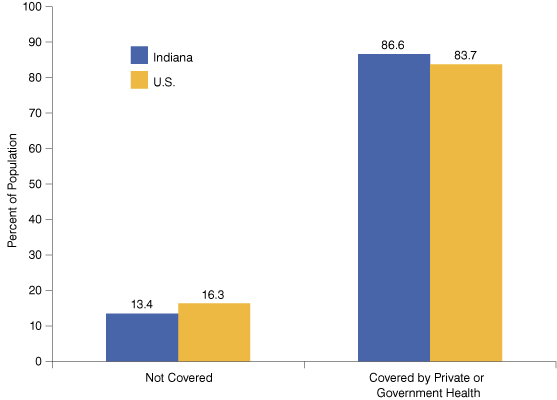
Source: IBRC, using Current Population Survey data
As shown in Figure 2, the majority of Hoosiers (60 percent) have health insurance through their employer, while 34 percent have government-based health insurance (Medicare, Medicaid or military health care). Note that the categories are not mutually exclusive (e.g., an individual may have both employment-based insurance alongside directly purchased supplemental coverage).
Figure 2: Types of Insurance Coverage, 2010
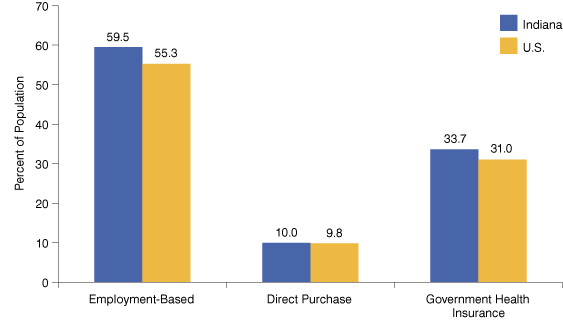
Note: Numbers to do not sum to 100 because the categories are not mutually exclusive. The difference between the U.S. and Indiana direct purchases is not statistically significant.
Source: IBRC, using Current Population Survey data
The percentage of insured individuals in Indiana has declined by 3.3 percentage points over the decade, although there was a slight uptick in 2010 (see Figure 3).
Figure 3: Percent of the Population Covered by Health Insurance, 2000 to 2010
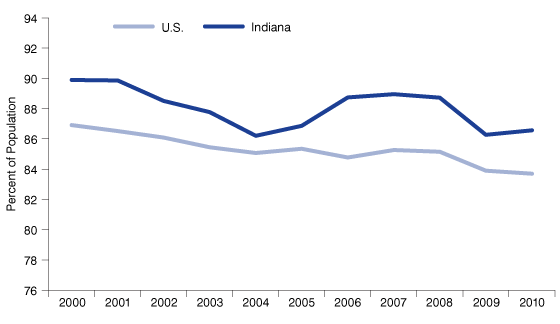
Source: IBRC, using Current Population Survey data
Change in coverage has been primarily due to a drop in the share of population with employment-based coverage, which fell 14 percentage points over the decade (see Figure 4).
Figure 4: Employment-Based Health Insurance in Indiana, 2000 to 2010
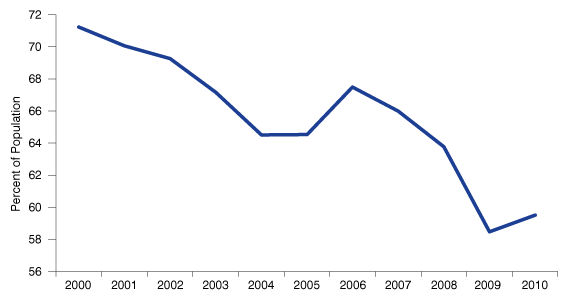
Source: IBRC, using Current Population Survey data
Meanwhile the percent of people with government-based insurance has been on the rise (see Figure 5). Since these figures are released annually, we can continue to track the number and percent of Hoosiers with health insurance and how the nature of that coverage may be changing.
Figure 5: Government Health Insurance in Indiana, 2000 to 2010
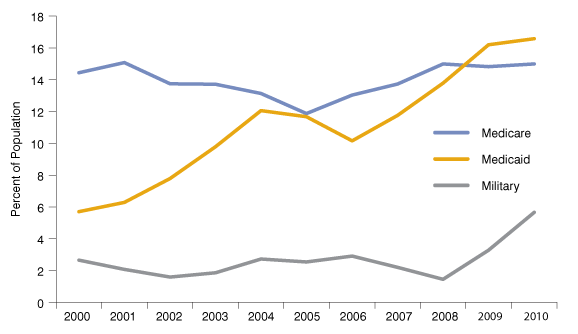
Source: IBRC, using Current Population Survey data
Learn More
This article explored just one data set on health insurance coverage. For more data on insurance coverage and health care costs, visit the STATS Indiana Health topic page.
Notes
- Data in this article come from the Current Population Survey (CPS) data available at www.census.gov/newsroom/releases/archives/news_conferences/2011-09-13_ipnews_conf.html. The American Community Survey (ACS) is now another source for health insurance data and is based on a larger sample size, but the time series is limited and only goes back to 2008. The 2010 ACS data indicate that 14.8 percent of Hoosiers are uninsured, compared to 15.5 percent for the United States. View the health insurance fact sheet for more information about the variety of data sources available.
Rachel Justis
Geodemographic Analyst, Indiana Business Research Center, Indiana University Kelley School of Business
